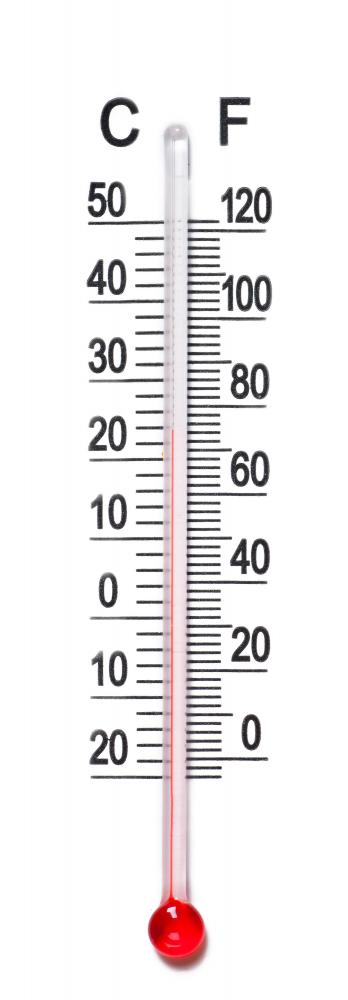What is the Centigrade Temperature Scale?
 Mary McMahon
Mary McMahon
The centigrade temperature scale, more properly known as the Celsius temperature scale, is a scale for measuring temperatures which is based on the behavior of water at normal pressure. This scale is widely used in much of the world to express temperatures, with a few holdout nations using the Fahrenheit temperature scale. The Celsius scale is also used as the benchmark for the Kelvin scale, which is used in the scientific community.
On the Celsius scale, the freezing point of water is set at 0 degrees, and the boiling point of water is 100 degrees. The scale is named for Anders Celsius, a Swedish man who developed one of the earliest versions of this scale. Somewhat confusingly, early versions of the centigrade temperature scale were reversed, with water freezing at 100 degrees and boiling at 0 degrees. Linnaeus is widely credited with being the first to use 0 as the freezing point.

The scale was widely referred to as the centigrade temperature scale until 1948, when it was changed to “Celsius” to avoid confusion with a unit of measurement which is also called a centigrade. However, many people continue to use the term “centigrade temperature scale,” especially members of the lay public who do not make a habit of checking on the proceedings of the General Conference of Weights and Measures. Both uses are widely understood, although scientists may wince when they hear “centigrade temperature scale.”
The basic concept of the Celsius scale was adapted in the course of the development of the Kelvin scale. The Kelvin temperature scale uses absolute 0, the coldest theoretically possible temperature, as the 0 point, making the freezing point of water 273.15 kelvins (32 degrees Fahrenheit). The 100 point distance between freezing and boiling is retained in the Kelvin scale, so water boils at 373.15 kelvins (212 degrees Fahrenheit). Incidentally, a kelvin is a unit of measurement, which is why temperatures are given in “kelvins,” not “degrees kelvin,” and by convention, “kelvin” is not capitalized when giving temperature measurements, although it is when discussing the Kelvin scale.
It is not uncommon to find a thermometer which gives measurements in Fahrenheit and Celsius, for the convenience of conversion between the two systems, especially in the United States. It can be helpful to know that one degree Fahrenheit is 5/9s of a degree Celsius, and the quickest way to approximate Celsius temperatures in Fahrenheit is to double and add 32, although the actual formula is (°C × 1.8) + 32.
AS FEATURED ON:
AS FEATURED ON:











Discussion Comments
I use the rough formula when I go swimming in Europe. If the temperature is reported to be 25 degrees Celsius, the rough way of figuring it out would be 82 degrees Fahrenheit, double the 25 and add 32.
The actual temperature would be 77 degrees Fahrenheit, but close enough to know that the sea is pleasantly warm.
Post your comments